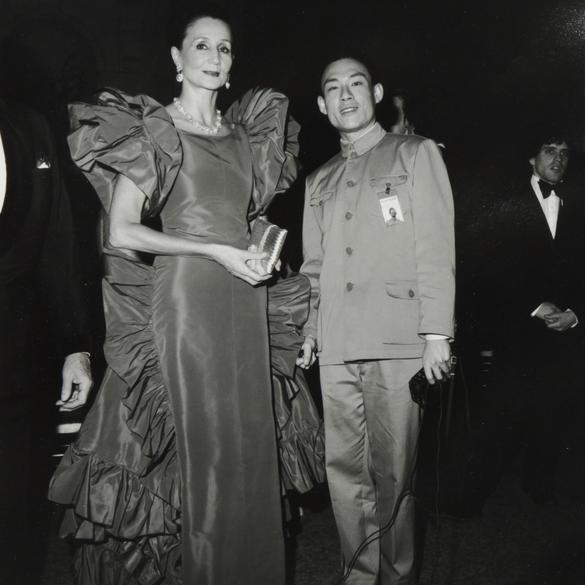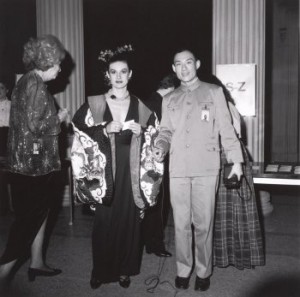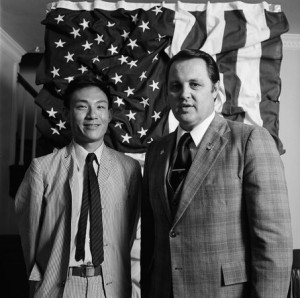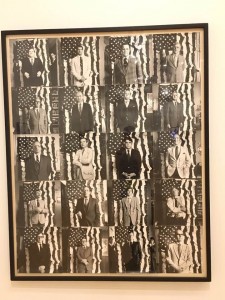Block Museum’s exhibition “Tseng Kwong Chi: Performing for the Camera” is a collection of the photographs of a photographer-performer Tseng Kwong Chi. Tseng Kwong Chi (1950-1990) is well-known for his photograph that juxtaposes the East and the West and is also noted for his works with other prominent artists, such as Keith Haring. Overall, he captures the moment in which the East (represented by his own identity) meets the West. Furthermore, in many of his works, Tseng highlights how his presence as a genuinely distant, and therefore uncertain and strange, Asian man actually enables him to belong at a place that is generally deemed inadequate for people like him at the time – Tseng was a queer man of color, an Asian immigrant from Hong Kong.
Tseng Kwong Chi’s photography displays how one’s appearance of power affects one’s interaction with others and, more specifically, distorts another’s perception about one’s power. For instance, appearance associated with power and authority can overcome the exclusion experienced by people due to their race and social status. In Tseng’s case, his most notable tactic in controlling other’s perception of his authority is through his uniforms. In many of his self-portraits taken in the United States, Tseng dresses up in Mao style uniform, and therefore sometimes disguises himself as a distant and ambiguous, yet authoritative man from China. In fact, during the time in which Asians were generally excluded from high-elite society, Tseng was able to infiltrate their social scenes and to genuinely appear as someone who “deserves to be there.” On the other hand, it is not always that Tseng wanted to appear as an ‘ambiguous ambassador.’ In fact, he sometimes tries to appear less powerful, in order to disarm others through his familiarity, as shown by his effort to arrange the Moral Majority exhibition. As such, Tseng displays how controlling one’s appearance can change one’s authority perceived by others, helping one to infiltrate exclusive social groups.
First, through the photographs he took with socially and culturally influential figures including Andy Warhol and Paloma Picasso, during the 1980 exhibition The Manchu Dragon: Costumes of the Ch’ing Dynasty, 1644-1912, Tseng exposes how one’s appearance of power can gain one an entry to socially exclusive circles. Furthermore, Tseng shows how manipulating another’s perception can sometimes be as easy as putting on a different uniform.
In the photos from that evening, Tseng in his Mao uniform stands next to celebrities and renowned artists, smiling genuinely at the camera. Celebrities next to Tseng, many in awkwardly ornate China-resembling outfits, stare at the camera with him. Although this photo may not appear so special at first, when one puts the photo in its context, it reveals the nature of power. In the photograph, the negative sentiments toward homosexuals, Asian immigrants, and Communism in the United States at the time become overshadowed by an image of possibly a very powerful, distant and therefore somewhat ambiguous, Chinese man in Mao style uniform. Under the authoritative exterior, a homosexual Asian man who was considered to be a minority stands with and becomes a part of the majority.
Ultimately, his appearance of authority enables him to belong to the party and to take photos with prominent social figures and artists. His difference in ethnicity overcomes exclusion through the appearance of power. It is not just his difference and uncertainty that gives him the successful infiltration. Tseng in Mao suit is indeed different from others at the party, but at the same time, he appears powerful. If he were only being different without the look of authority, he would not have succeeded in taking the photographs with people. He is different and powerful, and the uncertainty makes his power even more unfathomable. It is interesting to note that although Maoist uniform emphasizes his loyalty toward Communism (which the general Americans at the time were quite hostile to), at the same time, because he appears to be not just a Communist but also a powerful and authoritarian official, he was able to overcome others’ discomfort with such ideology. Tseng’s tactics in distorting other’s perception about him is simple; he puts on different uniforms to infiltrate exclusive social spaces. This simple tactic overcomes his identity limits; through the juxtaposition of his disguise in uniform and his gained entry to socially exclusive scene, Tseng lampoons the shallowness of the elite social circle.
Tseng Kwong Chi uses different uniforms to be perceived not only as more powerful but also as more familiar and less threatening. He dressed according to what he wanted to achieve in terms of his superficial social status. His Moral Majority exhibit is an example of which he dresses in seersucker suit to appear more familiar, friendly, and unaggressive. He introduces himself as a photo-journalist, and takes the photos of conservative politicians who identified themselves as the Moral Majority led by Jerry Farwell. Despite the members of the Moral Majority being generally anti-immigrants and homophobic, Tseng achieved to take the photos of them in carefully orchestrated setting. In the photographs, each pose in front of crumpled American flag. The members are all white with “self-righteous posturing.” Through the photos, Tseng Kwong Chi lampoons the extreme conservatism of the Moral Majority and its anti-gay, anti-feminist, and anti-immigrant sentiments. Their racial exclusivity as white, the crumpled flag, and self-righteous posture together provide ironic and therefore humorous image. As shown by one of the contact sheets that features Tseng posing with New York State Moral Majority chairman Daniel Fore, Tseng is dressed in genteel seersucker suit that makes him appear more familiar and less threatening. Tseng appears with less power and authority, and puts on the guise of a familiar man to successfully orchestrate the photoshoot. When the politicians became skeptical of what he was doing and asked why the flag was crumpled, Tseng assured them that it was to give the impression of a blowing flag. If Tseng had the appearance of a Communist diplomat, he would have not achieved to photograph the members of Moral Majority in front of the American flag, which its crumpled state gave the impression of the flag being sucked into, or devoured by, the politicians’ bodies.
Tseng Kwong Chi’s photographs thus reveal how one’s appearance of power can overcome one’s social identity. His uniforms not only set him different from or familiar to the photographed, but it also influences people’s perception about his power and authority. Tseng Kwong Chi lampoons the exclusivity of social elite groups by exposing how assailable their exclusivity is in front of artificial disguise created by just a simple change in outfit. Through his photos, Tseng Kwong Chi, a homosexual Asian immigrant, reveals the sad truth of what needs to be controlled to overcome social exclusion: authority and power.




755 Comments
I am thankful for the passion and enthusiasm you bring to your writing.
หวย magnum 4d
If you want to know the right tricks and the right numbers in the lottery game, you can visit our website because our website discusses the accuracy of lottery numbers and the right numbers. If you read it, you will definitely find it very easy to get a jackpot in the lottery because the articles we write are very useful for those of you who like the lottery game, and if you want to read it, you just click on our website here and read https://ekramit.net/